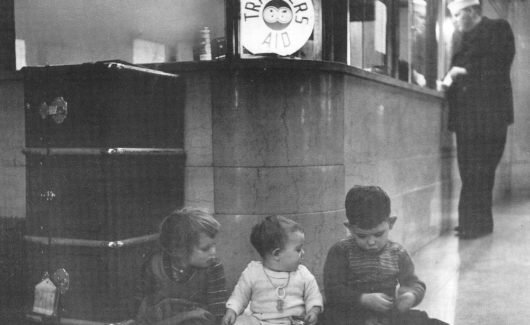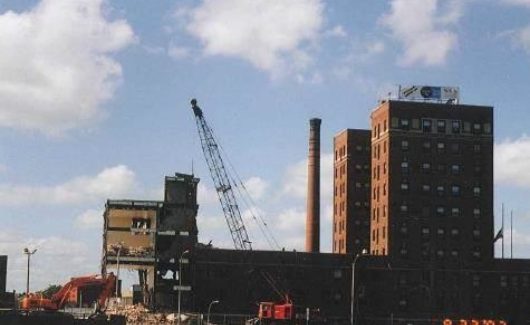
How We Started
In 1894, we were founded as Travelers Aid of Rhode Island. The goal was to assist people who came to Providence in search of work, many of whom were young women. Since then, we have evolved to meet the needs of the most vulnerable people in our state.
In 2004, in order to reflect all the changes that we had made, we changed our name to Crossroads Rhode Island and moved from downtown Providence into the former YMCA building at 160 Broad Street.
Explore our full timeline below!
1851
During the California Gold Rush, Mayor of St. Louis Bryan Mullanphy left a $1 million trust to his city for the purpose of "furnishing relief to immigrants and travelers coming to St. Louis on their way west." The bequest, reportedly written on a napkin, was the beginning of "traveler's aid." Other cities, including Providence, soon followed suit.

1894
Travelers Aid (now Crossroads Rhode Island) was founded by the YWCA to provide protection and aid to women and girls traveling alone.
Early 1900s
The original charter of Traveler's Aid was to protect "...young girls on arrival of the city, taking them to friends that failed to meet them, directing them to safe boarding places and finding employment for those who are without money or friends, thus preventing what might be their first step to ruin..."
1919
Travelers Aid proudly reported helping nearly 4,000 women since its inception.
1929
Travelers Aid began focusing its efforts on the "unattached transient" traveling by bus, trailer, automobile and train. These travelers, who ranged in age from 12 to 96, included those with lost tickets or wallets, immigrants, the unemployed and runaways.

1941
After Pearl Harbor, the work of Travelers Aid shifted to help the war effort in response to a 50% increase in requests for assistance from sailors, soldiers, defense workers and Marines. True to its charter, which stressed cooperation with other agencies, Travelers Aid worked closely with the United States Organization (USO).
1943
Travelers Aid had received 57,626 requests for assistance. When the war ended, Travelers Aid was awarded citations from the Navy and the War Department, as well as countless thank you letters from servicemen who said they were proud to fight for "...a country with an organization like Travelers Aid."
1950s
By mid-century, the rise of the automobile brought about a marked shift in how people traveled. In response, Travelers Aid information was posted more broadly in service stations, police stations, phone booths--even T.F. Green Airport.
1960s
As fewer people relied on public transportation, Travelers Aid began shifting its focus from a directory service to casework, assisting "individuals and families who needed help with problems, causing them to move, or resulting from their moving, whether for sociological, economic or psychological reasons."
"[The agency's mission] is an ever-changing one affected by economic and social factors, and it must shift priorities within its human services."
- From Travelers Aid's 1970 Minutes

1970s
Due to the deinstitutionalization of of the mentally ill, communities struggled with increasing drug, alcohol and mental health issues, Reflecting those concerns, Travelers Aid took on crisis intervention. As the minutes recall, the agency's mission "...is an ever-changing one affected by economic and social factors, and it must shift priorities within its human services."
1980s
Sparked by a deep recession, lack of affordable housing and drastic cutbacks in Federal housing funds, homelessness hit crisis levels in Rhode Island. In response, Travelers Aid evolved rapidly into a comprehensive, multifaceted agency, offering 24/7 services, mobile medical services, runaway youth programming and education and employment services.
1994
Travelers Aid acquires its first housing property, turning former Navy housing in North Kingstown into 58 transitional apartments for families. Today, this property is now known as Kingstown Crossings.

2004
Travelers Aid rebranded as Crossroads Rhode Island and moved into its current location at 160 Broad Street in Providence. As part of this move, the agency took over ownership and management of 192 permanent supportive housing apartments within the building.
2006
Crossroads opened the Harold Lewis House in West Warwick. Harold Lewis House provides housing for formerly homeless veterans and adults ages 50 and older.
2014
For an extended period between 2013 and 2014, Rhode Island had the highest unemployment rate in the nation. In a sweeping philosophical shift, Crossroads implemented Housing First. Unlike traditional shelter models, Housing First moves those with the greatest needs out of shelter and into housing as soon as possible. Once stabilized in housing, Crossroads provides the services and support necessary to help individuals and families achieve self-sufficiency.
2016
Recognizing domestic violence as a leading cause of homelessness for women, Crossroads merged with the Women's Center of Rhode Island. As part of the merger, Crossroads assumed ownership of a safe house in Providence and created its Domestic Violence Program. Later that year, Crossroads assumed management of Harrington Hall, the largest men's shelter in Rhode Island, and developed the Mike Terry Apartments in partnership with Whitmarsh House.

Today
Thanks to the ongoing support of our corporate partners, charitable foundations and generous donors, Crossroads is the leading provider of housing and services to the homeless in Rhode Island. Our agency owns or manages more than 350 residences statewide and provides services to thousands of individuals and families each year.
